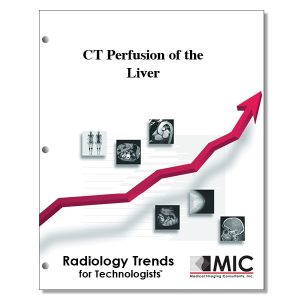

CT Perfusion of the Liver
Various oncologic applications of CT perfusion are discussed and current challenges, as well as possible solutions, for CT perfusion are presented.
Course ID: Q00429 Category: Radiology Trends for Technologists Modalities: CT, Radiation Therapy3.25 |
Satisfaction Guarantee |
$34.00
- Targeted CE
- Outline
- Objectives
Targeted CE per ARRT’s Discipline, Category, and Subcategory classification for enrollments starting after February 24, 2023:
[Note: Discipline-specific Targeted CE credits may be less than the total Category A credits approved for this course.]
Computed Tomography: 3.25
Safety: 0.25
Radiation Safety and Dose: 0.25
Procedures: 3.00
Abdomen and Pelvis: 3.00
Registered Radiologist Assistant: 1.00
Procedures: 1.00
Abdominal Section: 1.00
Outline
- Introduction
- Basic Principles of CT Perfusion Imaging
- CT Acquisition Protocol
- Calculation of CT Perfusion Parameters
- Single-Input versus Dual-Input Model
- Single-Compartment versus Dual-Compartment Model
- Dual-Compartment Model versus Distributed Parameter Model
- CT Perfusion Parameters
- Applications in Clinical Oncologic Imaging of the Liver
- General Introduction: Alteration of CT Perfusion Parameters in Liver tumors
- Early Detection of Liver Tumors
- Assessment of Prognosis Based on Tumor Perfusion
- Monitoring Therapeutic Effects
- Diagnosing Tumor Recurrence
- Current Challenges and Future Directions
- Radiation Dose
- Protocol Standardization
- Reproducibility
- Motion Correction
- Other Issues
- Conclusion
Objectives
Upon completion of this course, students will:
- be familiar with morphological imaging techniques used to diagnose liver disease
- identify challenges when performing CT perfusion imaging of the liver
- be familiar with the classification of RECIST
- identify the disadvantages of assessing tumor specimen with needle biopsy
- identify the most commonly used first-line imaging modality for staging and monitoring disease in oncology
- be knowledgeable about the units of attenuation in CT
- be familiar with the first phase of tissue enhancement during CT perfusion imaging of the liver
- be familiar with the second phase of tissue enhancement during CT perfusion imaging of the liver
- understand the unique blood supply to the liver
- identify the kinetic models used in CT perfusion imaging of the liver
- be familiar with the timing of the first phase of CT perfusion imaging of the liver
- be knowledgeable about the minimum concentration of iodine used in CT perfusion imaging of the liver
- identify the recommended rate of contrast media injection for CT perfusion imaging of the liver
- recognize the percentage of blood flow to the portal vein in the liver
- be familiar with the causes of increased hepatic arterial flow associated to hepatic metastases
- identify how the HAP is separated from the PVP
- be able to define HPI
- identify the various kinetic models used in CT perfusion imaging of the liver
- be familiar with the evolution of hepatocellular dysplastic nodules to HCC
- be familiar with the introduction of distributed parameter models
- be able to define MTT
- be able to define extraction fraction
- understand the effects of arteriovenous shunts on the MTT
- identify the clinical application of CT perfusion imaging of the liver
- be familiar with the early findings on CT perfusion imaging studies of the liver
- be familiar with the use of maximum slope in patients with HCC
- be familiar with the advantages of early detection rates in HCC
- be able to identify the process of confirmation of earlier detection of liver metastases with CT perfusion imaging of the liver
- be familiar with alternate techniques to performing CT perfusion imaging of the liver
- be able to define tumor angiogenesis
- be familiar with the use of HPI to determine patient survival
- be familiar with the use of antiangiogenic drugs for therapeutic treatment
- understand the limitations of PET imaging when using antiangiogenic drugs
- be able to define the acronym TACE
- identify the antiangiogenic agent used in the study reported by Ren et al
- be familiar with the techniques used to reduce radiation exposure during CT perfusion imaging of the liver
- be able to define AEF
- identify the current challenges for performing CT perfusion imaging of the liver
- understand the reason to use motion correction when performing CT perfusion imaging of the liver
- identify the different methods of motion correction when performing CT perfusion imaging of the liver
